|
Genus Stonogobiops - Symbiotic Gobies
The Pinnacle of Symbiosis in the Tropical Marine Aquarium 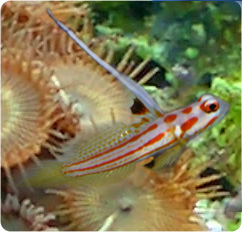 In the world of reef symbiosis, the reef aquarist can observe parasitic, commensal and mutualistic relationships between animals that form complex relationships in an effort to survive. The most famous of these relationships is obviously the anemone-clownfish pairing, which became synonymous with many people’s conception of the tropical reef following Nemo’s debut on the silver screen. Most marine aquarists know that there are many other symbiotic relationships that can be easily replicated and cultivated in the home aquarium including coral crabs and various species of coral, cleaner fishes and the fishes they clean, and, the subject of this article, shrimp gobies and so-called pistol shrimp. This last pairing is, in many aquarists’ minds, the pinnacle of symbiosis in the marine aquarium. It is what Scott Michael calls an “invertebrate-fish relationship that I think is even more amazing than [sea anemone-clownfish association].” In the world of reef symbiosis, the reef aquarist can observe parasitic, commensal and mutualistic relationships between animals that form complex relationships in an effort to survive. The most famous of these relationships is obviously the anemone-clownfish pairing, which became synonymous with many people’s conception of the tropical reef following Nemo’s debut on the silver screen. Most marine aquarists know that there are many other symbiotic relationships that can be easily replicated and cultivated in the home aquarium including coral crabs and various species of coral, cleaner fishes and the fishes they clean, and, the subject of this article, shrimp gobies and so-called pistol shrimp. This last pairing is, in many aquarists’ minds, the pinnacle of symbiosis in the marine aquarium. It is what Scott Michael calls an “invertebrate-fish relationship that I think is even more amazing than [sea anemone-clownfish association].”
A Mutualistic Relationship
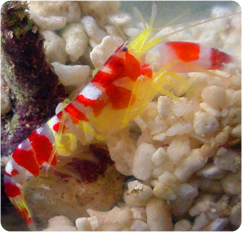 To return to the various kinds of symbiosis—parasitic, commensal and mutualistic—the shrimp goby-pistol shrimp relationship is a mutualistic one, meaning that each animal benefits from the relationship. Specifically, in some goby-shrimp pairings, the shrimp creates a burrow in which both animals can seek refuge and the goby acts as a sort of early warning device for the vulnerable shrimp when it sallies forth from the burrow to feed. Not all gobies that will form a relationship with shrimp are truly mutualistic, but many are, and these are the ones that can be recommended enthusiastically to the aquarist looking to add a fascinating display of unique animal behavior to his or her aquarium. To return to the various kinds of symbiosis—parasitic, commensal and mutualistic—the shrimp goby-pistol shrimp relationship is a mutualistic one, meaning that each animal benefits from the relationship. Specifically, in some goby-shrimp pairings, the shrimp creates a burrow in which both animals can seek refuge and the goby acts as a sort of early warning device for the vulnerable shrimp when it sallies forth from the burrow to feed. Not all gobies that will form a relationship with shrimp are truly mutualistic, but many are, and these are the ones that can be recommended enthusiastically to the aquarist looking to add a fascinating display of unique animal behavior to his or her aquarium.
Genus Stonogobiops
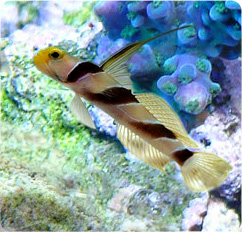 Gobies from the genus Stonogobiops are undoubtedly the poster fish of the shrimp goby world. Sometimes called the highfin gobies, these fishes are remarkable in their appearance, and nearly all will readily pair with pistol shrimp from the family Alpheidae. In addition, Stonogobiops species of gobies tend to be more active than other shrimp gobies. Three aquarium favorites are the Yasha Hase Shrimp Goby (Stonogobiops yasha), the yellow rose goby (Stonogobiops nematodes) and the Dracula goby (Stonogobiops Dracula). Gobies from the genus Stonogobiops are undoubtedly the poster fish of the shrimp goby world. Sometimes called the highfin gobies, these fishes are remarkable in their appearance, and nearly all will readily pair with pistol shrimp from the family Alpheidae. In addition, Stonogobiops species of gobies tend to be more active than other shrimp gobies. Three aquarium favorites are the Yasha Hase Shrimp Goby (Stonogobiops yasha), the yellow rose goby (Stonogobiops nematodes) and the Dracula goby (Stonogobiops Dracula).
A Small Peaceful Fish
As a rule, these are small (to two inches) peaceful fishes that really do require some forethought before adding them to an established aquarium. Stonogobiops shrimp gobies are easily harassed by more aggressive fishes or other substrate dwelling fishes (e.g., jawfishes, engineer gobies). These gobies can also become a meal for piscavorous invertebrates (e.g., anemones, crabs). For these reasons, it is best, if at all possible, to make sure the shrimp goby is one of the first fishes introduced to a new aquarium so that it can get itself established before more aggressive animals are present. Don’t worry about trying to help the shrimp goby and shrimp pair up; as long as they were released in the same general area of the tank, they will find each other.
Adding to an Established Aquarium
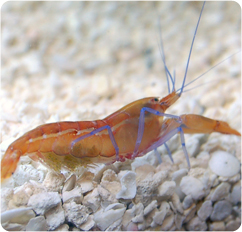 When introducing highfin gobies to an established aquarium, great care must be taken. While these fishes can survive and thrive in a community tank—even with some more aggressive tankmates—they can only do so if they have the opportunity to become established. Due to their reclusive nature, it is not uncommon to add a Stonogobiops shrimp goby to an established aquarium and not see it for several days (if not weeks!). Once the goby does emerge, if the aquarist does not take great care to target feed it (a difficult task for such a reclusive fish), the highfin goby can easily waste away and die of malnutrition if not outright starvation. When introducing highfin gobies to an established aquarium, great care must be taken. While these fishes can survive and thrive in a community tank—even with some more aggressive tankmates—they can only do so if they have the opportunity to become established. Due to their reclusive nature, it is not uncommon to add a Stonogobiops shrimp goby to an established aquarium and not see it for several days (if not weeks!). Once the goby does emerge, if the aquarist does not take great care to target feed it (a difficult task for such a reclusive fish), the highfin goby can easily waste away and die of malnutrition if not outright starvation.
Acclimation and Feeding
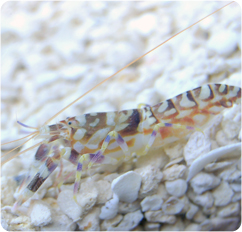 If, however, the shrimp goby is successfully introduced and acclimated, this fish will become one of your favorite (if not your favorite!) animals. There truly are few displays in the marine aquarium that can rival the mutualistic relationship between one of these boldly colored gobies and its attendant shrimp. In order to be successful, introduce the goby to an area of the tank where it can quickly find cover under live rock. Consider introducing the goby with the tank’s lights off, and resist the urge to try to spot the goby—you peering through the glass will only make the reclusive fish more reclusive. The goal is to encourage the goby to become established so that it will begin to feed. During the first few weeks, be sure to feed your more aggressive feeders on one side of the tank and then broadcast some food in the general direction of the goby’s burrow. Frozen mysid shrimp, Cyclop-eeze and Blue Zoo Mix (which is rihj in Cyclop-eeze) should all do the trick. If, however, the shrimp goby is successfully introduced and acclimated, this fish will become one of your favorite (if not your favorite!) animals. There truly are few displays in the marine aquarium that can rival the mutualistic relationship between one of these boldly colored gobies and its attendant shrimp. In order to be successful, introduce the goby to an area of the tank where it can quickly find cover under live rock. Consider introducing the goby with the tank’s lights off, and resist the urge to try to spot the goby—you peering through the glass will only make the reclusive fish more reclusive. The goal is to encourage the goby to become established so that it will begin to feed. During the first few weeks, be sure to feed your more aggressive feeders on one side of the tank and then broadcast some food in the general direction of the goby’s burrow. Frozen mysid shrimp, Cyclop-eeze and Blue Zoo Mix (which is rihj in Cyclop-eeze) should all do the trick.
Conclusion
If all goes well (and there is no reason it should not if you follow the above advice), your highfin goby will soon become a more aggressive eater and will often be visible hovering above the shrimp’s burrow. When the pistol shrimp moves away from the burrow, it will do so only if it can remain in contact with its goby, which, with a flick of its tail, will alert the shrimp to danger, sending both animals back to the burrow. While outstanding in a nano tank, don’t miss the opportunity to keep two specimens in a larger tank. Because the goby rarely ventures far from its burrow, chances are the two will never meet.
|